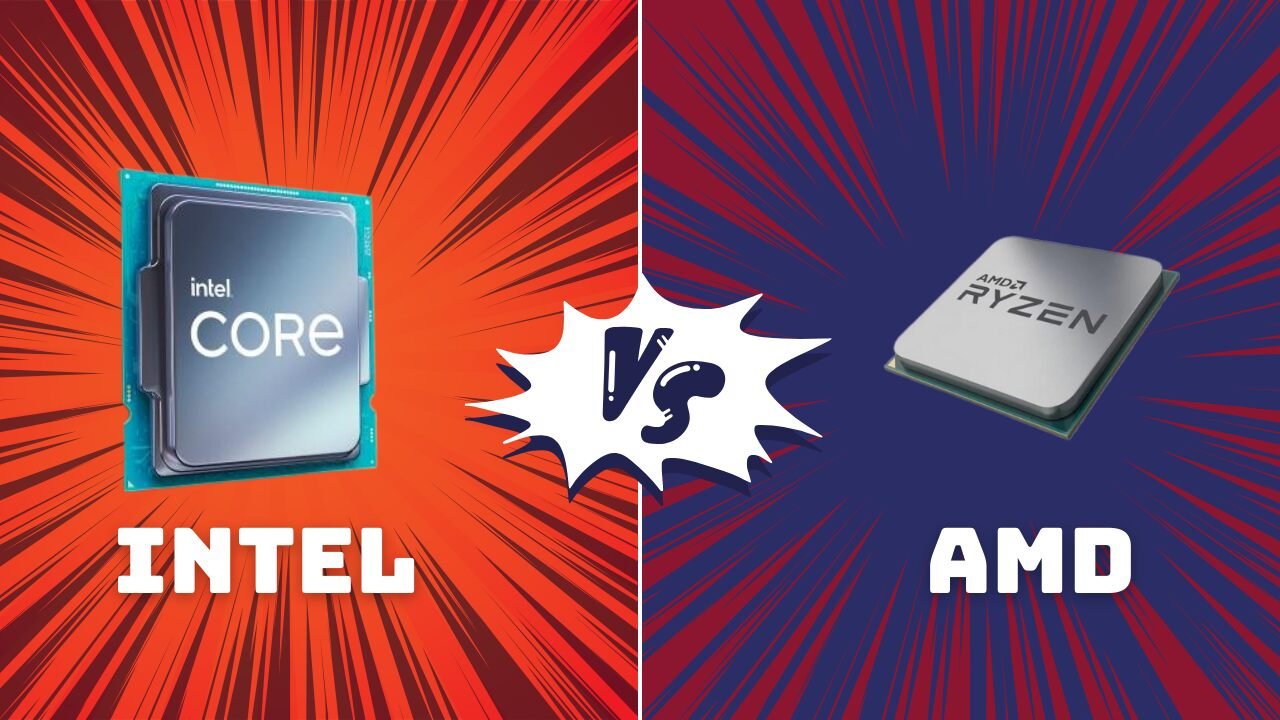In the heart of every computer lies the central processing unit (CPU), often referred to as the “brain” of your machine. It dictates how swiftly and efficiently your computer can tackle tasks, from browsing the web to running complex programs. With AMD and Intel as the two giants of the CPU industry, choosing the right processor can be a daunting task. This comprehensive guide will walk you through the nuances of AMD vs Intel, demystifying core counts, clock speeds, and helping you make an informed decision based on your specific needs.
Understanding Core Counts and Clock Speeds
Before diving into the specific offerings from AMD and Intel, let’s first break down two critical CPU features: core counts and clock speeds.
Cores: Modern CPUs contain multiple cores, which are individual processing units. Each core can handle separate tasks simultaneously, which makes multitasking smooth and efficient. For example, while one core handles your web browser, another can manage your video editing software or background tasks. More cores are essential for demanding applications such as video editing, game streaming, and running multiple applications at once.
Clock Speed: Measured in gigahertz (GHz), clock speed refers to how many cycles (or tasks) a CPU can complete per second. Higher clock speeds usually mean faster performance, especially in tasks that rely on a single core. However, for heavy multitasking, core count can often be more crucial than clock speed.
In summary, both core count and clock speed are important, but their importance depends on what you’ll be using your CPU for. Now, let’s dive into the two biggest players in the CPU market.
AMD Ryzen Processors: The Core Count Contender
Over the past few years, AMD has taken the market by storm with its Ryzen series of processors, offering high performance at competitive prices. Here’s why AMD has become a popular choice among gamers, content creators, and general users alike:
1. Core Count Advantage: AMD is known for offering CPUs with higher core counts than Intel at the same price point. For example, AMD’s Ryzen 9 processors can have up to 16 cores, making them ideal for tasks like video editing, 3D rendering, and other CPU-intensive workloads.
2. Multithreading: AMD processors excel in multithreading, where each core can handle multiple threads, improving multitasking efficiency. This is particularly valuable for software that can take advantage of multiple cores, such as virtual machines and creative applications like Adobe Premiere.
3. Power Efficiency: AMD’s Ryzen processors are generally more power-efficient than their Intel counterparts, meaning they generate less heat and consume less electricity. This results in cooler systems, longer battery life (for laptops), and potentially lower electricity bills.
4. Overclocking Potential: Many AMD CPUs are unlocked, meaning users can increase the clock speeds beyond the factory settings. For enthusiasts and gamers, this can provide a performance boost by adjusting CPU settings for faster performance.
Intel Core Processors: The Legacy of Performance
Intel has been a dominant force in the CPU market for decades, and while AMD has gained ground, Intel remains a strong contender, especially in certain performance areas. Here’s what makes Intel CPUs stand out:
1. Single-Core Performance: While AMD excels in multithreading, Intel typically holds the edge in single-core performance. This can make a difference in applications and games that rely more heavily on a single core, delivering higher frames per second (FPS) in games and better responsiveness in certain software.
2. Integrated Graphics (iGPU): Most Intel processors come with built-in graphics (known as Intel UHD or Iris Xe Graphics). For users who don’t need a dedicated graphics card, these integrated graphics can handle basic tasks, light gaming, and media consumption, making Intel CPUs more cost-effective for budget systems.
3. Software Optimization: Many software applications, especially older or more niche programs, have been optimized for Intel’s architecture. For certain professional software, Intel’s CPUs can deliver smoother performance simply because they’ve been a longstanding standard.
Picking Your Perfect Processor: Gamers, Creators, and Everyday Users
Your ideal CPU depends largely on how you plan to use your computer. Let’s break it down based on three common user types:
1. Gamers:
- High-End Gaming: For competitive and high-end gamers who prioritize frame rates and responsiveness, Intel’s Core i9 and Core i7 processors offer top-tier single-core performance. However, AMD’s Ryzen 7 7800X3D, with its innovative 3D V-Cache technology, has recently challenged Intel in gaming benchmarks, particularly in games that benefit from larger caches.
- Budget-Conscious Gamers: AMD’s Ryzen 5 processors (like the Ryzen 5600X) offer excellent gaming performance at more affordable prices, making them ideal for budget gamers who still want smooth gameplay without spending a fortune.
2. Content Creators:
- Multitasking Masters: AMD is often the better choice for content creators due to its high core counts and multithreading capabilities. The Ryzen 7 and Ryzen 9 processors are perfect for heavy multitasking—editing 4K video, rendering 3D models, or running multiple creative applications simultaneously.
- Single-Core Workloads: Some professional applications, such as certain design and CAD programs, still rely heavily on single-core performance. In these cases, Intel may hold a slight edge, though AMD is quickly closing the gap.
3. Everyday Users:
- Balanced Performance: For tasks like web browsing, document editing, and streaming, both AMD’s Ryzen 3 and Intel’s Core i3 processors are more than capable. They offer enough power for daily use without being overkill.
- Futureproofing: If you want to future-proof your system to handle more demanding applications down the road, consider investing in a processor with extra cores, such as an AMD Ryzen 5 or an Intel Core i5.
Beyond Cores and Speeds: Other Factors to Consider
While core count and clock speed are important, other factors can impact your CPU choice:
1. Motherboard Compatibility: Make sure the CPU you choose is compatible with your current motherboard. AMD’s Ryzen processors, for instance, use the AM4 socket, while Intel’s 12th and 13th generation processors use the LGA 1700 socket. Upgrading both the CPU and motherboard can significantly increase costs.
2. Power Supply Requirements: Higher-end CPUs often require more power to run efficiently. Ensure that your power supply can handle the load, or you may need to upgrade that as well.
3. Cooling Solutions: CPUs generate heat, and higher-end processors tend to run hotter. AMD’s Ryzen processors typically come with decent stock coolers, while Intel often requires aftermarket coolers for optimal performance, especially with higher-tier models.
The Ever-Evolving Landscape: The Future of AMD vs Intel
The competition between AMD and Intel continues to benefit consumers by driving innovation. Here are some trends to keep an eye on:
1. Core Efficiency: Both AMD and Intel are focusing on making their cores more efficient, delivering better performance while consuming less power. This is especially important for laptops and portable devices, where battery life is a major concern.
2. AI and Machine Learning: The next frontier in CPUs could be AI integration. Expect CPUs with integrated AI capabilities to help accelerate tasks like image recognition, video processing, and even gaming enhancements.
3. Continued Competition in Gaming and Content Creation: With AMD pushing innovative technologies like 3D V-Cache, and Intel continuing to refine its single-core performance, the CPU market is set to become even more competitive in gaming and content creation spaces.
Choosing Your Champion: It’s All About Your Needs
There is no universal winner in the AMD vs Intel debate—it all boils down to your specific requirements. Here’s a quick recap:
- Gamers: If frame rates are your priority, Intel’s high-end Core i7 and i9 processors are great choices, but AMD’s Ryzen 7 7800X3D is making waves in gaming. For budget gamers, Ryzen 5 offers excellent value.
- Content Creators: AMD’s Ryzen 7 and Ryzen 9 processors with high core counts are ideal for multitasking and creative work, though Intel may still offer better single-threaded performance for specific professional applications.
- Everyday Users: AMD’s Ryzen 3 and Intel’s Core i3 are more than enough for daily tasks, but if you want to future-proof your system, consider a mid-tier option like the Ryzen 5 or Core i5.
Beyond the Benchmarks: The Importance of a Balanced System
While a powerful CPU is critical, a balanced system ensures the best performance:
- RAM: At least 16GB of RAM is recommended for smooth multitasking and handling modern applications.
- Storage: An SSD is essential for faster boot times and overall system responsiveness compared to traditional hard drives.
- Graphics Card: If you’re a gamer or content creator, investing in a dedicated graphics card (GPU) can offload graphical tasks from the CPU, improving overall performance.
The Final Word: The CPU Choice is Yours!
In the end, your CPU choice should align with your needs, whether you’re a gamer, content creator, or everyday user. With AMD and Intel constantly innovating, the best advice is to evaluate your specific requirements, do your research, and make an informed decision. Happy computing!


